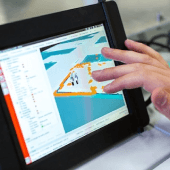Table of Content
- Visual Testing in NDT
- Application of Visual Testing
- What is Visual Acuity?
- How does Vision Work?
- NDT Visual Acuity Requirements
- Why is Visual Acuity Important for NDT Engineers?
Visual testing serves as a crucial aspect in the realm of NDT, offering invaluable insights into the integrity and quality of materials without causing harm to the tested objects. It plays a vital role in detecting surface defects, discontinuities, and abnormalities that may not be visible to the naked eye, ensuring the safety and reliability of structures and components in various industries.
What is Visual Testing in NDT?
Visual Testing is additionally called visual testing examination, nondestructive examination, or non-destructive analysis or examination. Visual Testing is the most ordinary technique that's utilized in trade nowadays. As a result, largely check strategies need the operator's vision at the surface that is half being inspected, Visual Examination is inherent in most of the opposite testing strategies. Because the name implies that, the American state involves the visually determined surface of a check material to judge the presence of surface discontinuities.
American state examination technique could also be by victimization line-of sight vision, Direct Viewing, or could also be increased or increases the clarity with the assistance of optical instruments like magnifying glasses, Charge-coupled Devices (CCDs), mirrors, boroscopes, and computer-assisted viewing systems (Remote Viewing). Placement within the material, Corrosion, physical harm, and cracks square measure some of the discontinuities that will be detected by visual examinations.
Applications of Visual Testing
Examine the leakage in the material:
Visual testing is employed to inspect materials for any signs of leakage, whether it's in pipes, containers, or other structures. By carefully examining the surface of the material, inspectors can detect cracks, holes, or other imperfections that may allow substances to escape or infiltrate, compromising the integrity of the material.
Examine the misalignment in the material:
Misalignment refers to the improper positioning or orientation of components within a material or structure. Visual testing helps identify misalignment by visually inspecting the alignment of parts, joints, or connections. This ensures that the material is assembled correctly and operates efficiently, reducing the risk of malfunctions or failures.
Cross-check the measurement of material according to the control charts or standards:
Visual testing is essential for verifying the dimensions and measurements of materials against established control charts or standards. Inspectors visually compare the actual dimensions of the material with the specifications outlined in the control charts or standards to ensure compliance and quality assurance.
Examine the surface conditions of the material:
Visual testing allows inspectors to assess the surface conditions of materials, including the presence of scratches, dents, corrosion, or other forms of damage. By visually inspecting the surface texture, colour, and appearance of the material, inspectors can identify any abnormalities or defects that may affect its performance or longevity.
By employing visual testing techniques, inspectors can thoroughly evaluate materials for leakage, misalignment, dimensional accuracy, surface conditions, and other critical factors, ensuring quality, safety, and compliance with industry standards.
What is Visual Acuity?
Visual Acuity is outlined because of the clarity of vision, measured by the flexibility to spot letters or numbers at a specific distance. You perhaps performed a visible acuity take a look at with a watch chart at the doctor's cabin. the quality of visual sense is 20/20 vision. If you have 20/20 vision, then you'll be able to simply scan and determine the conventional quantity of visual info at a distance of twenty feet. If you have 20/80 vision, then your vision at twenty feet is capable of someone standing eighty feet away with normal vision. Many of us don't meet the 20/20 vision normal, therefore thanks to that drawback individuals use optical lenses, and different optical things to correct their vision.
How does Vision Work?
Light enters through the pupil in our eye. It passes through the lens and is projected on the retina at the rear of the attention. The retina is created from photoreceptor cells called rods and cones. The motive of Rods is employed in dark conditions because they're sensitive to blue and green light with a maximum sensitivity of 498 nm wavelength. Cones give us our basic chromatic vision within the daylight, and they are comprised of L-cones, M-cones, and S-cones.
- L-Cones: Detect red light with a peak sensitivity of 564 nm
- M-cones: Detect green light with a peak sensitivity of 533 nm
- S-cones: Detect blue light with a peak sensitivity of 437 nm
NDT Visual Acuity Requirements
According to ASNT, visual certification for Associate in Nursing NDT Technician needs visual sense in a minimum of one eye. The visual sense is checked by someone properly reading the coastal diving bird J1 eye test chart, or equivalent, at a distance of thirty 5 cm or twelve in. In addition, an Associate in Nursing NDT Technician should be able to differentiate between the colors utilized in NDT ways. Eyes checks may be performed by a medical man or someone who's certified to offer the test.
Why is Visual Acuity Important for NDT Engineers?
Whether it's supersonic testing, Eddy Current Testing, or liquid penetrant testing, all NDT ways involve some kind of visual examination. For example, photography testing uses X-rays to come up with a picture on film, however, that film should be rigorously examined by the technician so as to get flaws. To boot, most Non-destructive Testing starts with the optic through visual scrutiny. Flaws seldom stand out sort of a waving red flag; scrutiny of an element is needed. That is why NDT Technicians should be trained and authorized. Otherwise, anyone might perform this work.
References:
1. ASME
2. Lufthansa Technik













